The Cotton Harvest: A Field of Dreams Planted with Hope and Harvested on Luck
In the fall of 2013, I met a Texas rancher named Peter Heyne while working in garden retail. Our relationship developed over a shared enthusiasm for plants and written words. A recent visit to Heyne Ranch during the 2017 epic Texas cotton harvest deepened our bond and opened our hearts to the challenges of a successful yield.
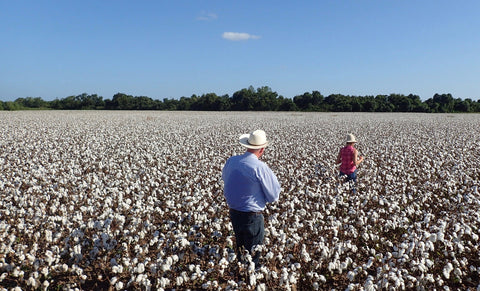
Peter Heyne and The Botanical Journey frolicking in a field of fluffy cotton.
Earliest Evidence of Cotton's Use
Interestingly, cotton is one of the few plants that are native to most tropical regions around the globe. The earliest archeological evidence dates cotton fiber use to approximately 6000 BCE in the Indus Valley of Asia and 5000 BCE in the Tehuacan Valley of Mexico. Cotton of the old world, Gossypium arboreum or tree cotton, can grow in a variety of colors, such as brown, pink, or green. This fiber was cultivated and woven into textiles adorning the people of India, China, and Egypt since prehistoric times. New world cotton, Gossypium hirsutum or Mexican cotton, is now cultivated around the globe. The fibers are naturally white, longer, and favored for modern textile production. Mexican cotton and its cultivars are the most widely used natural fiber in clothing today.
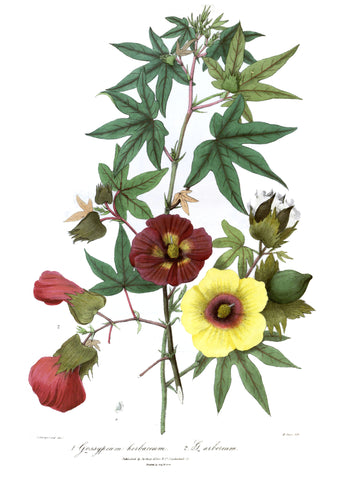
Gossypium Royle from 1839 Illustrations of the botany and other branches of the natural history of the Himalayan Mountains, Volume 2 by artist Vishnupersaud & text by John Forbes Royle.
How Cotton is Grown
Cotton is a member of the Malvaceae family and is related to okra and hibiscus. The inflorescence (the scientific term for flower) has five petals with a distinct central pistil for pollination (think hibiscus flower). Cotton is a perennial but is treated as an annual crop. In Texas, planting can begin in March or as late as April depending on the severity of winter. The seeds are sown in rows and the plants emerge in 5 to 7 days. Flower buds also referred to as 'squares,' form and open in approximately 2 months. The creamy blooms live for a single day; opening in the early morning and by afternoon, the pollen is released. Cotton plants are self-fertile and do not require wind or insects to reproduce. Once pollinated, the fickle flower turns pink never to reopen. As the flower dries, a boll develops pushing the flower to its final death of falling to the earth. The boll is the protective outer casing that surrounds the maturing cotton fiber and seeds, similar to an okra pod. When bolls mature, soft fluffy white cotton bursts forth. The entire crop from seed to harvest takes between 130 to 150 days. During the six months of a cotton crop, a number of fatal factors can affect the final harvest from late freezes and high winds to insects, diseases, and flooding. According to rancher Peter Heyne, "So much of it is just fricking luck."
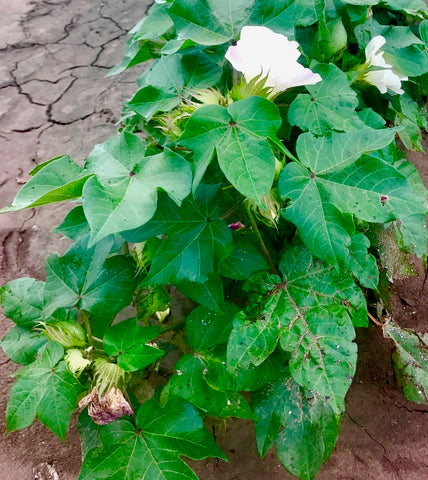
Cotton flowers, photo by Peter Heyne
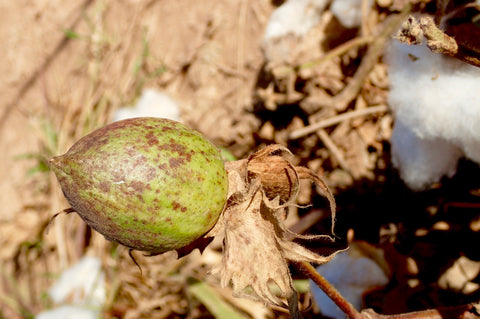
The cotton fiber and seeds are maturing inside this protective cotton boll.

Mature cotton ready for harvest
Click here to see a video of the fields
This year in Wharton County, about an hour southwest of Houston, the cotton fields are a glorious white sea reaching to the horizon. Thousands of acres are ready to be harvested by mid-August. The recent dry weather and a seven-day forecast of blue skies and sunshine has everyone excited for what looks like an excellent harvest. The landowners, contracted farmers, family, friends, and the nearby country neighbors, all gather to witness the industrial scale machines running down the rows harvesting the first bales of cotton. As the fluffy white fiber is gently lifted by a giant cotton picker reminiscent of an alien being from a Hollywood thriller, the sky fills with floating white puffs. Squeals of delight and smiles alight everyone's faces as hands reach high to catch some rogue fuzz flying in the wind. Even the teenagers look up from their phones mesmerized by the heavenly scene. Then, the crowd begins chatting about the potential yield. Briskly, farm hand Tim Merta, seizes the conversation, "Cotton's exciting. It's a lot of labor and fun. The fields look good, but, until it goes across the scale..." and finishes his statement with a shrug. We all follow the cue and turn the conversation to other topics.
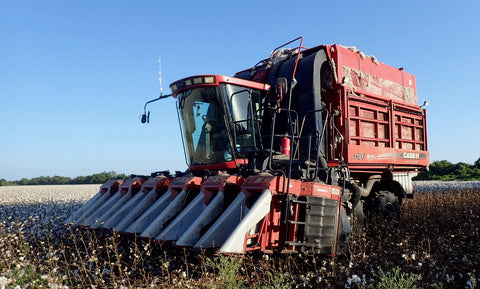
A cotton picker machine runs down the rows filling the "basket." The basket is emptied into the "boll buggy." Next, the boll buggy transfers the cotton into a "module maker," which compresses the cotton into a module. A module is the size of a train car and is the equivalent of about 18 bales of cotton. Each module is transported to a cotton gin for cleaning out any debris and seeds. Finally, clean cotton is formed into 500-pound bales and exported to manufacturers around the world.
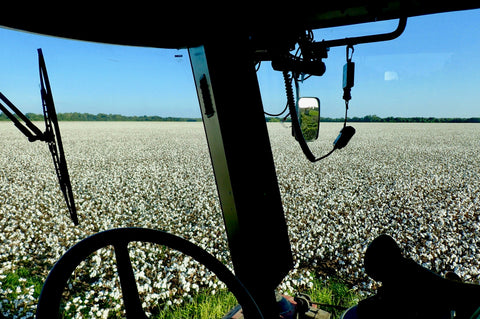
Inside the cotton picker
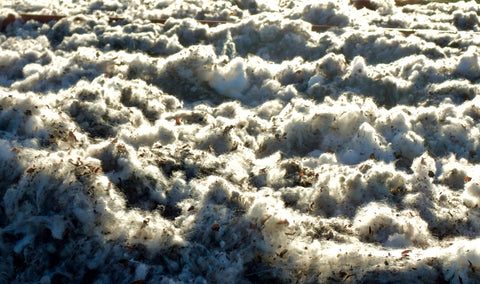
Freshly picked cotton in the buggy.

Boll Buggy emptying the cotton into the module maker. Photo by Peter Heyne

After the machine passes over the rows, only the outer protective casing or boll remains after harvest.
Click here to see a video from my ride inside the cotton picking machine.
I left as the sun dipped low on the horizon feeling exhilarated and a part of something bigger than my plant curiosity. For several days, Peter sent photographs of his fields being harvested. The following week, his bales were sent to the co-op cotton gin in Wharton County. Everything was set for a bumper crop.
As Luck Would Have It
The storm appeared like a plague. The first anyone heard about Harvey was as a tropical storm that rained on the Yucatan peninsula of Mexico. That was the Monday of the solar eclipse, so not much press or concern. Tuesday, a few mentions on news outlets had a couple of people talking about a storm system over the Gulf of Mexico. Wednesday morning, most Texans were still unaware of the named storm. Harvey was soon forecasted as a serious rain threat due to its slow movement. By Thursday, mandatory evacuations for the Texas coast were issued for a potential category 3 Hurricane. Friday, Harvey made landfall as a category 4 Hurricane destroying everything in its path. A year's worth of rain fell for 5 days along the Texas Gulf Coast from the slow-moving storm. The devastation to homes, businesses, and industry are incalculable. Many have referred to it as the 500-year storm.
Texas is the largest producer of cotton in the United States. Agricultural losses from Harvey in Wharton County and South Texas are severe. Heyne Ranch's bales of harvested cotton suffered damage from floodwaters at the co-op cotton gin. Water causes staining in the fiber from the seeds and washes away oil that contributes to the weight. What was fine cotton for textiles will now be used for a lower quality industrial fiber.
Everyone across the globe will feel the effects of Hurricane Harvey from oil and petrochemical production to agricultural losses and price increases in building materials. Extreme events help bring us together. It pains me to see such widespread devastation to so many families, friends, and industries. I feel blessed for my friendship with Peter and his invitation to share in the excitement and enthusiasm of this year's cotton crop. When he introduced me to the farmers and I told them I sell botanical t-shirts made from 100% cotton, everyone clapped, smiled, and thanked me for supporting their livelihood. If you have never walked into a vast field of cotton it is truly a sight to behold, a spiritual-like experience. Sincere Thanks to my friend Peter Heyne and to the farmers Keith, Boomer, A.J and Tim. May sunshine and luck be with your cotton harvest next season.
To see media coverage of the flooded cotton harvest click here
Interesting Facts About Cotton
The U.S. is the third largest producer of cotton behind China and India.
An acre of cotton is approximately equal to 1200 t-shirts.
In 2015 the world cotton market was worth an estimated $77 billion US dollars.

Leave a comment
Please note, comments must be approved before they are published